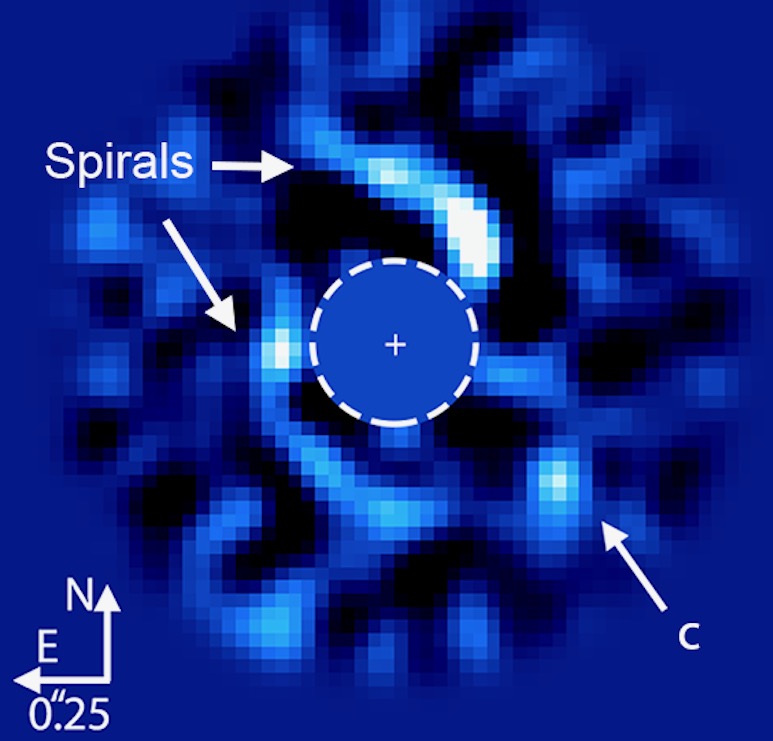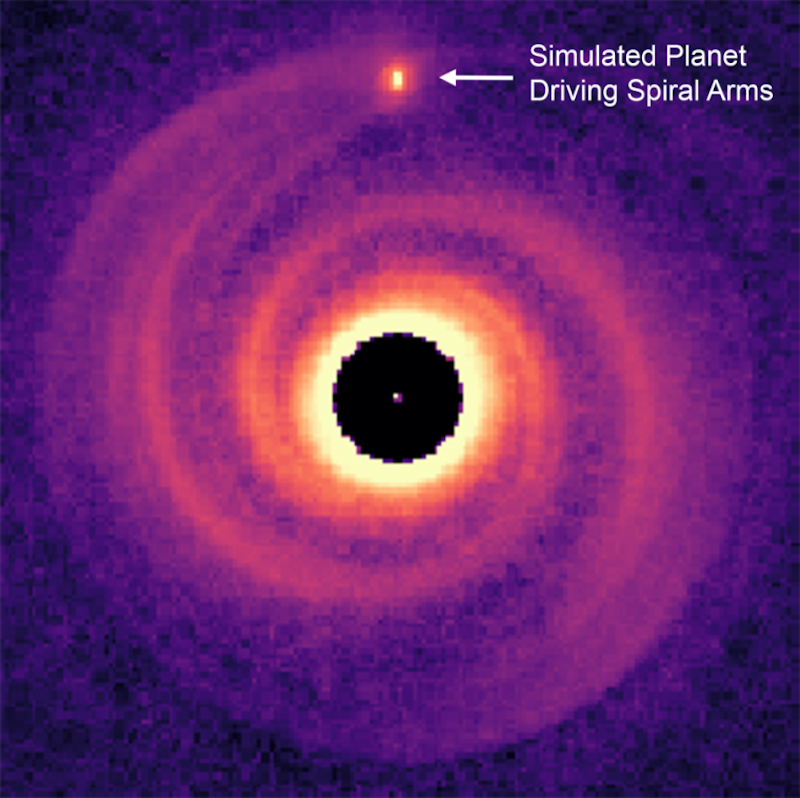
We’ve all seen images of our Milky Way galaxy, and other galaxies, with their majestic spiral arms. Those arms curve around the dense centers of the galaxies, much like a pinwheel. In recent years, astronomers have learned that spiral arms can also exist in the disks of dust and gas around newly forming stars. But how do these star-spirals form? Scientists have theorized that nascent planets – newly born from the same cloud of gas and dust creating the young stars – might create the spiral arms. And now, for the first time, astronomers have obtained images of a young giant planet that seems to confirm this theory. Researchers at The University of Arizona led the new study, and announced the discovery on July 6, 2023.
The research team, led by Kevin Wagner, also published their peer-reviewed findings in Nature Astronomy on July 6. You can read a free preprint version of the paper on arXiv.
Did MWC 758c create spiral arms around its star?
MWC 758c is a newborn gas giant type planet orbiting its young star about 500 light-years from Earth. Scientists estimate this system to be only a few million years old. That’s like an infant in terms of age compared to our sun at 4.6 billion years.
Wagner said:
I think of this system as an analogy for how our own solar system would have appeared less than 1% into its lifetime. Jupiter, being a giant planet, also likely interacted with and gravitationally sculpted our own disk billions of years ago, which eventually led to the formation of Earth.
Because the system is so young, it still has a disk of dust and gas around, called a protoplanetary disk. Astronomers first saw distinct spiral arms in the disk in 2013. Theoretical simulations at the time suggested that giant planets might be responsible for the spiral arms. As the paper states:
Understanding the driving forces behind spiral arms in protoplanetary disks remains a challenge due to the faintness of young giant planets. MWC 758 hosts such a protoplanetary disk with a two-armed spiral pattern that is suggested to be driven by an external giant planet.
Now, using the Large Binocular Telescope Observatory in Arizona, the researchers were able to finally detect and confirm the existence of MWC 758c.
How giant planets creates spiral arms in protoplanetary disks
The observations of the planet and its protoplanetary disk also appear to confirm what scientists suspected. MWC 758c is creating the spiral arms. In addition, it is helping smaller planets to form. As Wagner explained:
Our study puts forward a solid piece of evidence that these spiral arms are caused by giant planets. Spiral arms can provide feedback on the planet formation process itself. Our observation of this new planet further supports the idea that giant planets form early on, accreting mass from their birth environment, and then gravitationally alter the subsequent environment for other, smaller planets to form.
So, how do the spiral arms form? We have evidence now that giant planets can create the spiral arms. But just how do they form? Basically, the newly-forming planet exerts its gravitational pull on other material around the star, in the disk. The giant planet disrupts the orbiting material, creating a spiral pattern in the process.
Why wasn’t MWC 758c detected before?
There was another puzzle that astronomers were trying to figure out as well. Why hadn’t the planet – or similiar ones creating spiral arms – been detected until now? A young giant planet still in the process of forming gives off a lot of heat and light. Wagner commented on this, saying:
It was an open question as to why we hadn’t seen any of these planets yet. Most models of planet formation suggest that giant planets should be very bright shortly after their formation, and such planets should have already been detected.
For MWC 758c, the answer was that it was so red. It looked much redder than other young exoplanets. Those shorter, redder wavelengths are more difficult to detect by most telescopes. This is due to the thermal glow of Earth’s atmosphere and even the telescope itself. This is where the Large Binocular Telescope comes in. The paper says:
We present observations in the thermal infrared that are uniquely sensitive to redder (that is, colder, or more attenuated) planets than past observations at shorter wavelengths. We detect a giant protoplanet, MWC 758c, at a projected separation of roughly 100 AU from the star.
One AU, or astronomical unit, is the mean distance from Earth to the sun.
The researchers used a specialized instrument on the telescope, the Large Binocular Telescope Interferometer, or LBTI. It connects the telescope’s two 8.4-meter primary mirrors and can observe at longer wavelengths in the mid-infrared range. The camera operates in a similar manner to NASA’s James Webb Space Telescope (JWST).
The research team searched for the giant planet with LBTI and … there it was!

Why is MWC 758c so bright?
So why is the planet brighter at longer wavelengths? Co-author Steve Ertel explained:
We propose two different models for why this planet is brighter at longer wavelengths. Either this is a planet with a colder temperature than expected, or it is a planet that’s still hot from its formation, and it happens to be enshrouded by dust.
Co-author Kaitlin Kratter added:
If there is a lot of dust surrounding this planet, the dust will absorb shorter wavelengths, or bluer light, making the planet appear bright only at longer, redder wavelengths. In the other scenario of a colder planet surrounded by less dust, the planet is fainter and emits more of its light at longer wavelengths.
Implications and conclusions
If indeed there is a lot of dust around the young planet, that may mean that moons will eventually form. However, if there is less dust, then it could mean that planets can form colder than usually expected. Either way, the discovery of MWC 758c provides valuable clues about how planets form and how they affect their surrounding environment around their stars.
With this in mind, the discovery has provided astronomers with one big clue, Wagner noted:
In either case, we now know that we need to start looking for redder protoplanets in these systems that have spiral arms.
Overall, the new study comes to two main conclusions, as the paper states:
The existence of MWC 758c has two important implications: 1) faint and red giant planets are capable of driving large-scale spiral structures in protoplanetary disks, and 2) protoplanets in a similar phase of evolution to MWC 758c (in particular, with similarly red spectra) would likely have been missed by past surveys–including those performed in the accretion tracing H? filter (59). Mid-IR observations, like those presented here, and those that are now possible with JWST, are able to reveal these young (and likely very red) protoplanets.
Bottom line: Spiral arms are common in galaxies, but they can also form in disks of dust and gas around young stars. A new discovery shows how giant planets create them.
Source: Direct images and spectroscopy of a giant protoplanet driving spiral arms in MWC 758











